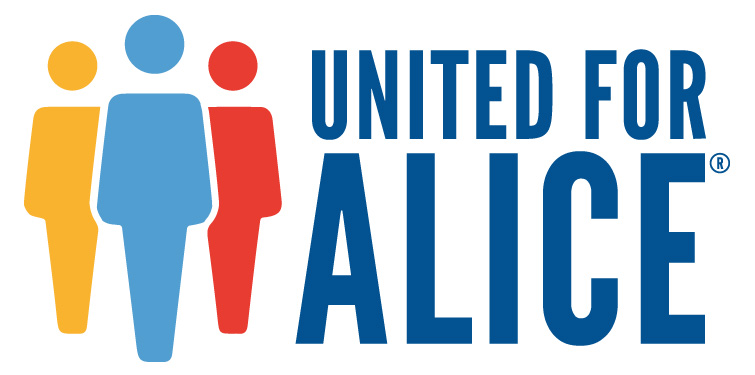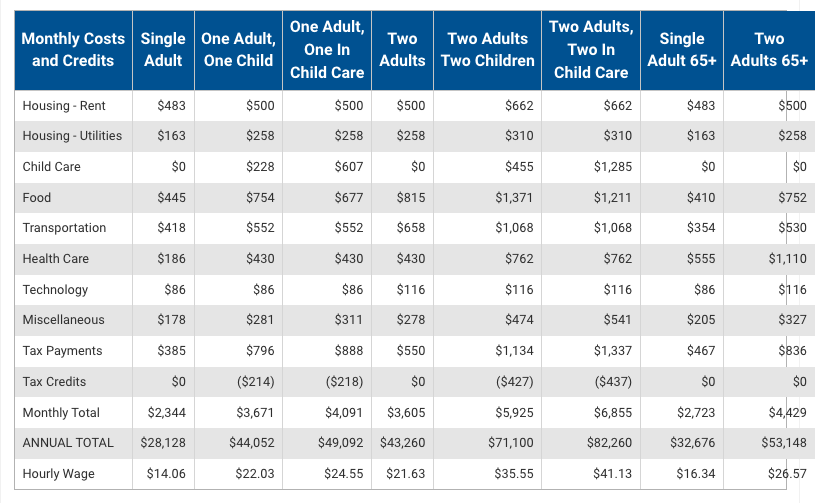

Who is ALICE?
ALICE is an acronym for Asset Limited, Income Constrained, Employed. They represent an astounding 43% of Washington County households that live at or below the ALICE threshold. Although they are working, perhaps multiple jobs, ALICE is not able to afford the basics such as food, clothing, housing, and childcare.
Many in this group earn too much to qualify for assistance programs, so their need is often overlooked. ALICE is your child care worker, the cashier at your supermarket, the gas attendant, the salesperson at your big box store, your waitress, a home health aide, an office clerk.
For far too many families, the cost of living outpaces what they earn. When funds run short, cash-strapped households are forced to make impossible choices, such as deciding between quality child care or paying the rent, filling a prescription or fixing the car. These short-term decisions have long-term consequences not only for ALICE, but for all of us.
ALICE cannot always pay the bills, has little or nothing in savings, and is forced to make tough choices such as deciding between quality child care or paying the rent. One unexpected car repair or medical bill can push these financially strapped families over the edge.
The future success of our communities is directly tied to the financial stability of these fragile ALICE households.
Impact to Households
Created by United for ALICE, the new ALICE Economic Viability Dashboard reveals the impact of economic and community conditions on people living in households below the ALICE Threshold. These households are either in poverty or are ALICE (Asset Limited, Income Constrained, Employed) — earning above the poverty level but less than the cost of basics. With more than 30 new ALICE variables on work, housing, and community supports, this Dashboard provides a way to explore needs and pair them with promising practices — empowering us to develop targeted solutions for households in hardship.
How You Can Help
Contributions to The ALICE Project are welcome throughout the year. Whether you choose to designate your entire gift to The ALICE Project or split your contribution between the annual campaign and The ALICE Project, your generosity makes a meaningful impact.
We are deeply grateful for your support, no matter how you choose to invest in the mission of the United Way of Washington County, MD.
Ready to make a difference today? Simply click the red button below to help us provide service and supports to our local ALICE individuals and families. Together, we can continue transforming lives and strengthening our community.
The United For ALICE Household Survival Budget is a minimum estimate of how much a household needs to spend on essentials, taxes, and a contingency fund. The budget is calculated for different household sizes and compositions in each Maryland county.
How the budget is calculated
- Includes housing, child care, food, transportation, health care, and a smartphone plan
- Adds taxes and a 10% contingency fund
- Adjusts for seniors' lower food costs and health needs
Using the budget
- The budget can be used to determine if a household's income is enough to cover basic needs
- The United For ALICE Wage Tool can be used to see if a selected hourly wage can support the budget in different counties
What the budget shows
- The budget highlights the financial challenges faced by Asset Limited, Income Constrained, Employed (ALICE) households
- The budget shows how traditional economic measures underestimate the actual cost of basic needs
Related resources
- The 2024 ALICE Report provides a look at the extent of financial hardship in Maryland
- The UnitedForALICE website has more information about ALICE in Maryland

2024 ALICE Update - ALICE in the Crosscurrents
With the latest data from various sources, this Update highlights the conflicting forces that continue to present opportunities for, and barriers to, financial stability in Maryland.
ALICE & Covid-19 - Understanding the Impact
The ALICE Report for Maryland presents the latest ALICE data available — a point-in-time snapshot of economic conditions across the state in 2018. By showing how many Maryland households were struggling then, the ALICE Research provides the backstory for why the COVID-19 crisis is having such a devastating economic impact. The ALICE data is especially important now to help stakeholders identify the most vulnerable in their communities and direct programming and resources to assist them throughout the pandemic and the recovery that follows. And as Maryland moves forward, this data can be used to estimate the impact of the crisis over time, providing an important baseline for changes to come.
United for ALICE - 2022 Washington County ALICE Profile
In order to better understand this growing population, United For ALICE provides a framework, language, statistics, and tools that community stakeholders can use to inform policy and drive innovation. The Research Center is the hub of UnitedForALICE.org — a one-stop source for exploring the latest ALICE data, on a national scale down to the local level in our partner states. Use the tabs to navigate the Research Center.
2018 Report - A Study of Financial Hardships in Maryland
ALICE Reports provide high-quality, research-based information to foster a better understanding of who is struggling in our communities. To produce the ALICE Report for Maryland, our team of researchers collaborated with a Research Advisory Committee composed of experts from across the state. Research Advisory Committee members from our partner states also periodically review the ALICE Methodology. This collaborative model ensures that the ALICE Reports present unbiased data that is replicable, easily updated on a regular basis, and sensitive to local context
